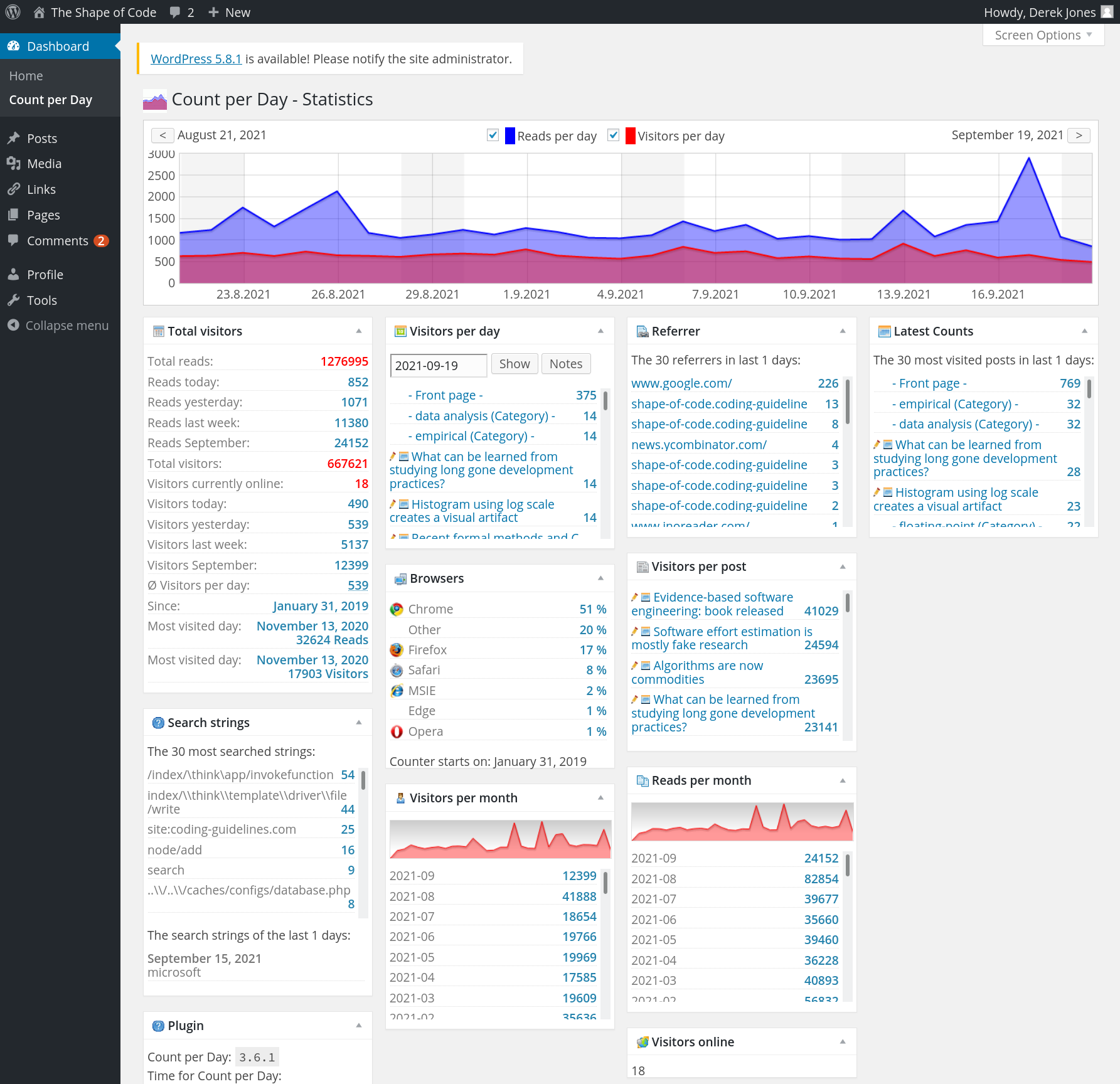Archive
Electronic Evidence and Electronic Signatures: book
Electronic Evidence and Electronic Signatures by Stephen Mason and Daniel Seng is not the sort of book that I would normally glance at twice (based on its title). However, at this start of the year I had an interesting email conversation with the first author, a commentator who worked for the defence team on the Horizon IT project case, and he emailed with the news that the fifth edition was now available (there’s a free pdf version, so why not have a look; sorry Stephen).
Regular readers of this blog will be interested in chapter 4 (“Software code as the witness”) and chapter 5 (“The presumption that computers are ‘reliable'”).
Legal arguments are based on precedent, i.e., decisions made by judges in earlier cases. The one thing that stands from these two chapters is how few cases have involved source code and/or reliability, and how simplistic the software issues have been (compared to issues that could have been involved). Perhaps the cases involving complicated software issues get simplified by the lawyers, or they look like they will be so difficult/expensive to litigate that the case don’t make it to court.
Chapter 4 provided various definitions of source code, all based around the concept of imperative programming, i.e., the code tells the computer what to do. No mention of declarative programming, where the code specifies the information required and the computer has to figure out how to obtain it (SQL being a widely used language based on this approach). The current Wikipedia article on source code is based on imperative programming, but the programming language article is not so narrowly focused (thanks to some work by several editors many years ago 😉
There is an interesting discussion around the idea of source code as hearsay, with a discussion of cases (see 4.34) where the person who wrote the code had to give evidence so that the program output could be admitted as evidence. I don’t know how often the person who wrote the code has to give evidence, but these days code often has multiple authors, and their identity is not always known (e.g., author details have been lost, or the submission effectively came via an anonymous email).
Chapter 5 considers the common law presumption in the law of England and Wales that ‘In the absence of evidence to the contrary, the courts will presume that mechanical instruments were in order. Yikes! The fact that this is presumption is nonsense, at least for computers, was discussed in an earlier post.
There is plenty of case law discussion around the accuracy of devices used to breath-test motorists for their alcohol level, and defendants being refused access to the devices and associated software. Now, I’m sure that the software contained in these devices contains coding mistakes, but was a particular positive the result of a coding mistake? Without replicating the exact conditions occurring during the original test, it could be very difficult to say. The prosecution and Judges make the common mistake of assuming that because the science behind the test had been validated, the device must produce correct results; ignoring the fact that the implementation of the science in software may contain implementation mistakes. I have lost count of the number of times that scientist/programmers have told me that because the science behind their code is correct, the program output must be correct. My retort that there are typos in the scientific papers they write, therefore there may be typos in their code, usually fails to change their mind; they are so fixated on the correctness of the science that possible mistakes elsewhere are brushed aside.
The naivety of some judges is astonishing. In one case (see 5.44) a professor who was an expert in mathematics, physics and computers, who had read the user manual for an application, but had not seen its source code, was considered qualified to give evidence about the operation of the software!
Much of chapter 5 is essentially an overview of software reliability, written by a barrister for legal professionals, i.e., it is not always a discussion of case law. A barristers’ explanation of how software works can be entertainingly inaccurate, but the material here is correct in a broad brush sense (and I did not spot any entertainingly inaccuracies).
Other than breath-testing, the defence asking for source code is rather like a dog chasing a car. The software for breath-testing devices is likely to be small enough that one person might do a decent job of figuring out how it works; many software systems are not only much, much larger, but are dependent on an ecosystem of hardware/software to run. Figuring out how they work will take multiple (expensive expert) people a lot of time.
Legal precedents are set when both sides spend the money needed to see a court case through to the end. It’s understandable why the case law discussed in this book is so sparse and deals with relatively simple software issues. The costs of fighting a case involving the complexity of modern software is going to be astronomical.
The Approximate Number System and software estimating
The ability to perform simple numeric operations can improve the fitness of a creature (e.g., being able to select which branch contains the most fruit), increasing the likelihood of it having offspring. Studies have found that a wide variety of creatures have a brain subsystem known as the Approximate Number System (ANS).
A study by Mechner rewarded rats with food, if they pressed a lever N times (with N taking one of the values 4, 8, 12 or 16), followed by pressing a second lever. The plot below shows the number of lever presses made before pressing the second lever, for a given required N; it suggests that the subject rat is making use of an approximate number system (code+data):

Humans have a second system for representing numbers, which is capable of exact representation, it is language. The Number Sense by Stanislas Dehaene was on my list of Christmas books for 2011.
One method used to study the interface between the two number systems, available to humans, involves subjects estimating the number of dots in a briefly presented image. While reading about one such study, I noticed that some of the plots showed patterns similar to the patterns seen in plots of software estimate/actual data. I emailed the lead author, Véronique Izard, who kindly sent me a copy of the experimental data.
The patterns I was hoping to see are those invariably seen in software effort estimation data, e.g., a power law relationship between actual/estimate, consistent over/under estimation by individuals, and frequent use of round numbers.
Psychologists reading this post may be under the impression that estimating the time taken to implement some functionality, in software, is a relatively accurate process. In practice, for short tasks (i.e., under a day or two) the time needed to form a more accurate estimate makes a good-enough estimate a cost-effective option.
This Izard and Dehaene study involved two experiments. In the first experiment, an image containing between 1 and 100 dots was flashed on the screen for 100ms, and subjects then had to type the estimated number of dots. Each of the six subjects participated in five sessions of 600 trials, with each session lasting about one hour; every number of dots between 1 and 100 was seen 30 times by each subject (for one subject the data contains 1,783 responses, other subjects gave 3,000 responses). Subjects were free to type any value as their estimate.
These kinds of studies have consistently found that subject accuracy is very poor (hardly surprising, given that subjects are not provided with any feedback to help calibrate their estimates). But since researchers are interested in patterns that might be present in the errors, very low accuracy is not an issue.
The plot below shows stimulus (number of dots shown) against subject response, with green line showing  , and red line a fitted regression model having the form
, and red line a fitted regression model having the form  (which explains just over 70% of the variance; code+data):
(which explains just over 70% of the variance; code+data):

Just like software estimates, there is a good fit to a power law, and the only difference in accuracy performance is that software estimates tend not to be so skewed towards underestimating (i.e., there are a lot more low accuracy overestimates).
Adding subjectID to the model gives:  , with
, with  varying between 0.65 and 1.57; more than a factor of two difference between subjects (this model explains just under 90% of the variance). This is a smaller range than the software estimation data, but with only six subjects there was less chance of a wider variation (code+data).
varying between 0.65 and 1.57; more than a factor of two difference between subjects (this model explains just under 90% of the variance). This is a smaller range than the software estimation data, but with only six subjects there was less chance of a wider variation (code+data).
The software estimation data finds shows that accuracy does not improve with practice. The experimental subjects were not given any feedback, and would not be expected to improve, but does the strain of answering so many questions cause them to get worse? Adding trial number to the model suggests a 12% increase in underestimation, over 600 trials. However, adding an interaction with SubjectID shows that the performance of two subjects remains unchanged, while two subjects experience a 23% increase in underestimation.
The plot below shows the number of times each response was given, combining all subjects, with commonly given responses in red (code+data):

The commonly occurring values that appear in software estimation data are structured as fractions of units of time, e.g., 0.5 hours, or 1 hour or 1 day (appearing in the data as 7 hours). The only structure available to experimental subjects was subdivisions of powers of 10 (i.e., 10 and 100).
Analysing the responses by subject shows that each subject had their own set of preferred round numbers.
To summarize: The results from an experiment investigating the interface between the two human number systems contains three patterns seen in software estimation data, i.e., power law relationship between actual and estimate, individual differences in over/underestimating, and extensive use of round numbers.
Izard’s second experiment limited response values to prespecified values (i.e., one to 10 and multiples of 10), and gave a calibration example after each block of 46 trials. The calibration example improved performance, and the use of round numbers as prespecified response values had the effect of removing spikes from the response counts (which were relatively smooth; code+data)).
We now have circumstantial evidence that software developers are using the Approximate Number System when making software estimates. We will have to wait for brain images from a developer in an MRI scanner, while estimating a software task, to obtain more concrete proof that the ANS is involved in the process. That is, are the areas of the brain thought to be involved in the ANS (e.g., the intraparietal sulcus) active during software estimation?
The Shape of Code is moving
This blog is moving to a new’ish domain (shape-of-code.com), and hosting company (HostGator). The existing url (shape-of-code.coding-guidelines.com) will continue to work for at least a year, and probably longer.
A beta version of the new site is now running. If things check out (please let me know if you see any issues), https://shape-of-code.com will become the official home next weekend, and the DNS entry for shape-of-code.coding-guidelines.com will be changed to point to the new address.
The existing coding-guidelines.com website has been hosted by PowWeb since June 2005. These days few people will have heard of PowWeb, but in 2005 they often appeared in the list of top hosting sites. I have had a few problems over the years, but I suspect nothing that I would have experienced from other providers. Over time, the functionality provided by PowWeb has decreased, compared to what they used to offer and what others offer today. But since my site usage has been essentially hosting a blog, I have not had a reason to move.
While I have had a nagging feeling I ought to move to a major provider, it was not until a post caused the site to be taken off-line because of a page-views per-hour limit being exceeded, that I decided to move. The limit was exceeded because an article appeared on news.ycombinator and became more popular, more rapidly, than my previous article appearances on ycombinator (which have topped out at 20K+ hits). Customer support were very responsive and quickly reset the page counter, once I contacted them and explained the situation. But why didn’t they inform me (I rarely hear from them, apart from billing, and one false alarm about the site sending spam), and why no option to upgrade?
The screenshot below shows that the daily traffic is around 1K views (mostly from Google searches), with 20k+ daily peak views every few months (sometimes months after the article was posted):

Eight months later, the annual fee is due; time for action. HostGator is highly rated by many hosting reviews, and offered site migration (never having migrated a website before, I did not know it was essentially ftp’ing the contents, and maybe some basic WordPress stuff). I signed up.
As you may have guessed, my approach to website maintenance is: If it’s not broken, don’t fix it. This meant the site was running the oldest version of WordPress (4.2.30) and PHP (5.2, which reached end-of-life 10 years ago) that PowWeb supported.
As I learned about website and WordPress migration, I thought: I can do that. My Plan B was to get HostGator to do it.
WordPress migration turned out to be straight forward:
- export blog contents. WordPress generates an xml file,
- edit the xml file, replacing all occurrences of
shape-of-code.coding-guidelines.combyshape-of-code.com, - create WordPress blog on HostGator (to minimise the chance of incompatibilities I stayed with version 4, HostGator offers 4.9.18), selected a few options, and installed a few basic add-ons,
- ftp directories containing images and code+data to new site,
- import contents of xml file (there is a 512M limit, my file was 5.5M).
It worked 🙂
I was not happy with the theme visually closest to the current blog (Twenty Sixteen), so I tried installing the existing theme (iNove). Despite not being maintained for eight years, it works well enough for me to decide to run with it.
I’m hoping that the new site will run with minimal input from me (apart from writing articles) for the next 10-years.
Mutation testing: its days in the limelight are over
How good a job does a test suite do in detecting coding mistakes in the program it tests?
Mutation testing provides one answer to this question. The idea behind mutation testing is to make a small change to the source code of the program under test (i.e., introduce a coding mistake), and then run the test suite through the mutated program (ideally one or more tests fail, as-in different behavior should be detected); rinse and repeat. The mutation score is the percentage of mutated programs that cause a test failure.
While Mutation testing is 50-years old this year (although the seminal paper did not get published until 1978), the computing resources needed to research it did not start to become widely available until the late 1980s. From then, until fuzz testing came along, mutation testing was probably the most popular technique studied by testing researchers. A collected bibliography of mutation testing lists 417 papers and 16+ PhD thesis (up to May 2014).
Mutation testing has not been taken up by industry because it tells managers what they already know, i.e., their test suite is not very good at finding coding mistakes.
Researchers concluded that the reason industry had not adopted mutation testing was that it was too resource intensive (i.e., mutate, compile, build, and run tests requires successively more resources). If mutation testing was less resource intensive, then industry would use it (to find out faster what they already knew).
Creating a code mutant is not itself resource intensive, e.g., randomly pick a point in the source and make a random change. However, the mutated source may not compile, or the resulting mutant may be equivalent to one created previously (e.g., the optimised compiled code is identical), or the program takes ages to compile and build; techniques for reducing the build overhead include mutating the compiler intermediate form and mutating the program executable.
Some changes to the source are more likely to be detected by a test suite than others, e.g., replacing <= by > is more likely to be detected than replacing it by < or ==. Various techniques for context dependent mutations have been proposed, e.g., handling of conditionals.
While mutation researchers were being ignored by industry, another group of researchers were listening to industry's problems with testing; automatic test case generation took off. How might different test case generators be compared? Mutation testing offers a means of evaluating the performance of tools that arrived on the scene (in practice, many researchers and tool vendors cite statement or block coverage numbers).
Perhaps industry might have to start showing some interest in mutation testing.
A fundamental concern is the extent to which mutation operators modify source in a way that is representative of the kinds of mistakes made by programmers.
The competent programmer hypothesis is often cited, by researchers, as the answer to this question. The hypothesis is that competent programmers write code/programs that is close to correct; the implied conclusion being that mutations, which are small changes, must therefore be like programmer mistakes (the citation often given as the source of this hypothesis discusses data selection during testing, but does mention the term competent programmer).
Until a few years ago, most analysis of fixes of reported faults looked at what coding constructs were involved in correcting the source code, e.g., 296 mistakes in TeX reported by Knuth. This information can be used to generate a probability table for selecting when to mutate one token into another token.
Studies of where the source code was changed, to fix a reported fault, show that existing mutation operators are not representative of a large percentage of existing coding mistakes; for instance, around 60% of 290 source code fixes to AspectJ involved more than one line (mutations usually involve a single line of source {because they operate on single statements and most statements occupy one line}), another study investigating many more fixes found only 10% of fixes involved one line, and similar findings for a study of C, Java, Python, and Haskell (a working link to the data, which is a bit disjointed of a mess).
These studies, which investigated the location of all the source code that needs to be changed, to fix a mistake, show that existing mutation operators are not representative of most human coding mistakes. To become representative, mutation operators need to be capable of making coupled changes across multiple lines/functions/methods and even files.
While arguments over the validity of the competent programmer hypothesis rumble on, the need for multi-line changes remains.
Given the lack of any major use-cases for mutation testing, it does not look like it is worth investing lots of resources on this topic. Researchers who have spent a large chunk of their career working on mutation testing will probably argue that you never know what use-cases might crop up in the future. In practice, mutation research will probably fade away because something new and more interesting has come along, i.e., fuzz testing.
There will always be niche use-cases for mutation. For instance, how likely is it that a random change to the source of a formal proof will go unnoticed by its associated proof checker (i.e., the proof checking tool output remains unchanged)?
A study based on mutating the source of Coq verification projects found that 7% of mutations had no impact on the results.
Testing rounded data for a circular uniform distribution
Circular statistics deals with analysis of measurements made using a circular scale, e.g., minutes past the hour, days of the week. Wikipedia uses the term directional statistics, the traditional use being measurements of angles, e.g., wind direction.
Package support for circular statistics is rather thin on the ground. R’s circular package is one of the best, and the book “Circular Statistics in R” provides the only best introduction to the subject.
Circular statistics has a few surprises for those new to the subject (apart from a few name changes, e.g., the von Mises distribution is effectively the ‘circular Normal distribution’), including:
- the mean value contains two components, a direction and a length, e.g., mean wind direction and strength,
- there are several definitions of variance, with angular variance having a value between 0 and 2, and circular variance having a value between 0 and 1. The circular standard deviation is not the square root of variance, but rather:
 , where
, where  is the mean length.
is the mean length.
The basic techniques used in circular statistics are still relatively new, compared to the more well known basic statistical techniques. For instance, it was recently discovered that having more measurements may reduce the reliability of the Rao spacing test (used to test whether a sample has a uniform circular distribution); generally, having more measurements improves the reliability of a statistical test.
The plot below shows Rose diagrams for the number of commits in each 3-hour period of a day for Linux and FreeBSD (mean direction and length in green; code+data):

The Linux kernel source has far fewer commits at the weekend, compared to working days. Given the number of people whose job is to work on the Linux kernel, compared to the number of people doing it out of interest, this difference is not surprising. The percentage of people working on OpenBSD as a job is small, and there does not appear to be a big difference between weekends and workdays. There is a lot of variation in the number of commits during each 3-hour period of a day, but the number of commits per day does not vary so much; the number of OpenBSD commits per day of week is:
Mon Tue Wed Thu Fri Sat Sun
26909 26144 25705 25104 24765 22812 24304 |
Does this distribution of commits per day have a uniform distribution (to some confidence level)?
Like all measurements, those made on a circular scale are rounded to some number of digits. Measurements may also be rounded, or binned, to particular units of the scale, e.g., measured to the nearest degree, or nearest minute.
A recent paper, by Landler, Ruxton and Malkemper, found that for samples containing around five hundred or more measurements, rounding to the nearest degree was sufficient to cause the Rao spacing test to almost always report non-uniformity, i.e., for non-trivial samples the rounding was sufficient to cause the test to detect non-uniformity (things worked as expected for samples containing fewer than 100 measurements).
Landler et al found that adding a small amount of noise (drawn from a von Mises distribution) to the rounded measurements appeared to ‘fix’ the incorrect behavior, i.e., rejecting the hypothesis of a uniform distribution, when a uniform distribution may be present.
The rao.spacing.test function, in the circular package, rejected that null hypothesis that the OpenBSD daily data has a uniform distribution. However, when noise is added to each day value (i.e., adding a random fraction to the day values, using rvonmises(length(c_per_day), circular(0), 2.0), although runif(length(c_per_day)) is probably more appropriate {and produces essentially the same result}), the call to rao.spacing.test failed to reject the null hypothesis of uniformity at the 0.05 level (i.e., the daily distribution is probably uniform).
How many research results are affected by this discovery?
I very rarely encounter the use of circular statistics (even though they should probably have been used in places), but then I spend my time reading software engineering papers, whose use of statistics tends to be primitive. I plan to include a brief mention of the use of the Rao spacing test with binned data in the addendum to my Evidence-based software engineering book (which includes the above example).
Multiple estimates for the same project
The first question I ask, whenever somebody tells me that a project was delivered on schedule (or within budget), is which schedule (or budget)?
New schedules are produced for projects that are behind schedule, and costs get re-estimated.
What patterns of behavior might be expected to appear in a project’s reschedulings?
It is to be expected that as a project progresses, subsequent schedules become successively more accurate (in the sense of having a completion date and cost that is closer to the final values). The term cone of uncertainty is sometimes applied as a visual metaphor in project management, with the schedule becoming less uncertain as the project progresses.
The only publicly available software project rescheduling data, from Landmark Graphics, is for completed projects, i.e., cancelled projects are not included (121 completed projects and 882 estimates).
The traditional project management slide has some accuracy metric improving as work on a project approaches completion. The plot below shows the percentage of a project completed when each estimate is made, against the ratio  ; the y-axis uses a log scale so that under/over estimates appear symmetrical (code+data):
; the y-axis uses a log scale so that under/over estimates appear symmetrical (code+data):

The closer a point to the blue line, the more accurate the estimate. The red line shows maximum underestimation, i.e., estimating that the project is complete when there is still more work to be done. A new estimate must be greater than (or equal) to the work already done, i.e.,  , and
, and  .
.
Rearranging, we get:  (plotted in red). The top of the ‘cone’ does not represent managements’ increasing certainty, with project progress, it represents the mathematical upper bound on the possible inaccuracy of an estimate.
(plotted in red). The top of the ‘cone’ does not represent managements’ increasing certainty, with project progress, it represents the mathematical upper bound on the possible inaccuracy of an estimate.
In theory there is no limit on overestimating (i.e., points appearing below the blue line), but in practice management are under pressure to deliver as early as possible and to minimise costs. If management believe they have overestimated, they have an incentive to hang onto the time/money allocated (the future is uncertain).
Why does management invest time creating a new schedule?
If information about schedule slippage leaks out, project management looks bad, which creates an incentive to delay rescheduling for as long as possible (i.e., let’s pretend everything will turn out as planned). The Landmark Graphics data comes from an environment where management made weekly reports and estimates were updated whenever the core teams reached consensus (project average was eight times).
The longer a project is being worked on, the greater the opportunity for more unknowns to be discovered and the schedule to slip, i.e., longer projects are expected to acquire more re-estimates. The plot below shows the number of estimates made, for each project, against the initial estimated duration (red/green) and the actual duration (blue/purple); lines are loess fits (code+data):

What might be learned from any patterns appearing in this data?
When presented with data on the sequence of project estimates, my questions revolve around the reasons for spending time creating a new estimate, and the amount of time spent on the estimate.
A lot of time may have been invested in the original estimate, but how much time is invested in subsequent estimates? Are later estimates simply calculated as a percentage increase, a politically acceptable value (to the stakeholder funding for the project), or do they take into account what has been learned so far?
The information needed to answer these answers is not present in the data provided.
However, this evidence of the consistent provision of multiple project estimates drives another nail in to the coffin of estimation research based on project totals (e.g., if data on project estimates is provided, one estimate per project, were all estimates made during the same phase of the project?)
Readability: a scientific approach
Readability, as applied to software development today, is a meaningless marketing term. Readability is promoted as a desirable attribute, and is commonly claimed for favored programming languages, particular styles of programming, or ways of laying out source code.
Whenever somebody I’m talking to, or listening to in a talk, makes a readability claim, I ask what they mean by readability, and how they measured it. The speaker invariably fumbles around for something to say, with some dodging and weaving before admitting that they have not measured readability. There have been a few studies that asked students to rate the readability of source code (no guidance was given about what readability might be).
If somebody wanted to investigate readability from a scientific perspective, how might they go about it?
The best way to make immediate progress is to build on what is already known. There has been over a century of research on eye movement during reading, and two model of eye movement now dominate, i.e., the E-Z Reader model and SWIFT model. Using eye-tracking to study developers is slowly starting to be adopted by researchers.
Our eyes don’t smoothly scan the world in front of us, rather they jump from point to point (these jumps are known as a saccade), remaining fixed long enough to acquire information and calculate where to jump next. The image below is an example from an eye tracking study, where subjects were asking to read a sentence (see figure 770.11). Each red dot appears below the center of each saccade, and the numbers show the fixation time (in milliseconds) for that point (code):

Models of reading are judged by the accuracy of their predictions of saccade landing points (within a given line of text), and fixation time between saccades. Simulators implementing the E-Z Reader and SWIFT models have found that these models have comparable performance, and the robustness of these models are compared by looking at the predictions they make about saccade behavior when reading what might be called unconventional material, e.g., mirrored or scarmbeld text.
What is the connection between the saccades made by readers and their understanding of what they are reading?
Studies have found that fixation duration increases with text difficulty (it is also affected by decreases with word frequency and word predictability).
It has been said that attention is the window through which we perceive the world, and our attention directs what we look at.
A recent study of the SWIFT model found that its predictions of saccade behavior, when reading mirrored or inverted text, agreed well with subject behavior.
I wonder what behavior SWIFT would predict for developers reading a line of code where the identifiers were written in camelCase or using underscores (sometimes known as snake_case)?
If the SWIFT predictions agreed with developer saccade behavior, a raft of further ‘readability’ tests spring to mind. If the SWIFT predictions did not agree with developer behavior, how might the model be updated to support the reading of lines of code?
Until recently, the few researchers using eye tracking to investigate software engineering behavior seemed to be having fun playing with their new toys. Things are starting to settle down, with some researchers starting to pay attention to existing models of reading.
What do I predict will be discovered?
Lots of studies have found that given enough practice, people can become proficient at handling some apparently incomprehensible text layouts. I predict that given enough practice, developers can become equally proficient at most of the code layout schemes that have been proposed.
The important question concerning text layout, is: which one enables an acceptable performance from a wide variety of developers who have had little exposure to it? I suspect the answer will be the one that is closest to the layout they have had the most experience,i.e., prose text.
Cognitive bias or not paying enough attention?
Assume you are responsible for two teams who independently work on projects, say Team A and Team B. The teams have different work completion rates, with Team A completing work at the rate of 70 widgets per week, while Team B completes 30 widgets per week. Both teams always work on projects that require the completion of the same number of widgets.
You have the resources to send just one of the teams on a course. It is predicted that sending Team A on the course would improve their performance to 110 widgets per week, while attending the course would improve the performance of Team B to 40 widgets per week.
Senior management have decreed that time to market is the metric by which project managers are judged.
You want to impress senior management by significantly improving time to market for your projects; which team do you send on the course (i.e., the one that is likely to experience the largest reduction in time to market)?
This question is a restatement of a one involving cars travelling at different speeds, that has grown into a niche research area. Studies have found that a large percentage of subjects give the wrong answer, and they are said to have a time-saving bias, or time-loss bias.
The inability to correctly process “inverse variables” has been given as the reason people tend to give the wrong answer. The term “inverse variables” comes from the formula for calculating completion time, where the velocity appears as the denominator. Another way of looking at this problem is that when going slowly, there is more scope for improvement, compared to when going much faster.
A speed increase from 30 to 40 is only 10, or a 33% improvement; while an increase from 70 to 110 is an increase of 40, or 57%. Based on these numbers, Team A should be sent on the course.
However, we are interested in time to market. Let’s assume that both teams have to complete a project requiring 100 widgets. Before attending the course, Team A completes 100 widgets in 100/70=1.4 weeks, and Team B completes 100 widgets in 100/30=3.3 weeks. After attending the course, Team A would complete 100 widgets in 100/110=0.91 weeks, and Team B would complete 100 widgets in 100/40=2.5 weeks. Time to market for Team A has been reduced by (1.4-0.9)=0.5 weeks, while the reduction for Team B is (3.3-2.5)=0.8 weeks. So sending Team B on the course makes you look better, on the time to market metric.
If somebody ran an experiment with project managers, would the subjects tend to incorrectly process “inverse variables”. Well, somebody has done the experiment, and yes, many subjects exhibited the time-saving bias (the experimental scenario described in the appendix is a lot easier to understand than the one in the main body of the paper, which is a mess; Magne Jørgensen continues to be the only person doing interesting experiments in software estimation).
It has become common practice that, when a large percentage of subjects in a psychology experiment respond in ways that are inconsistent with a mathematical approach, the behavior is labelled as being a bias. I think the use of this terminology makes the behavior sound more interesting than it actually is; what’s wrong with saying that people make mistakes. Perhaps labelling experimental responses as being a bias makes it easier to get papers published.
Whether people are biased, or don’t pay enough attention, when solving non-trivial equations, what might be done about it?
This is not about whether any particular metric is a useful one, rather it is about calculating the right answer for whatever metric happens to be chosen.
Would an awareness campaign highlighting the problems people have with “inverse variables” be worthwhile? I don’t think so. Many people have problems with equations, and I don’t see why this case is more worthy of being highlighted than any other.
Am I missing something?
Psychology researchers are interested in figuring out the functioning of the brain/mind, so they are looking for patterns in the responses subjects give. Once someone has published a few papers on a research topic, they become invested in it. If they continue to get funding, the papers keep on coming. Sometimes a niche topic acquires a major following, and the work contributes to a major change of thinking about the mind, e.g., the Wason selection task helped increase the evidence that culture has an impact on cognitive behavior.
I think that software engineering researchers need to carefully evaluate the likely importance of behaviors that psychology researchers have labelled as a bias.
Actual implementation times are often round numbers
To what extent do developers consciously influence the time taken to actually complete a task?
If the time estimated to complete a task is rather generous, a developer has the opportunity to follow Parkinson’s law (i.e., “work expands so as to fill the time available for its completion”), or if the time is slightly less than appears to be required, they might work harder to finish within the estimated time (like some marathon runners have a target time)?
The use of round numbers are a prominent pattern seen in task estimation times.
If round numbers appeared more often in the actual task completion time than would be expected by chance, it would suggest that developers are sometimes working to a target time. The following plot shows the number of tasks taking a given amount of actual time to complete, for project 615 in the CESAW dataset (similar patterns are present in the actual times of other projects; code+data):

The red lines are a fitted bi-exponential distribution to the ‘spike’ (i.e., round numbers, circled in grey) and non-spike points (spikes automatically selected, see code for details), green and purple lines are the two components of the non-spike fit.
Tasks are not always started and completed in one continuous work session, work may be spread over multiple work sessions; the CESAW data includes the start/end time of every work session associated with each task (85% of tasks involve more than one work session, for project 615). The following plots are based on work sessions, rather than tasks, for tasks worked on over two (left) and three (right) sessions; colored lines denote session ordering within a task (code+data):

Shorter sessions dominate for the last session of task implementation, and spikes in the counts indicate the use of round numbers in all session positions (e.g., 180 minutes, which may be half a day).
Perhaps round number work session times are a consequence of developers using round number wall-clock times to start and end work sessions. The plot below shows (left) the number of work sessions starting at a given number of minutes past the hour, and (right) the number of work sessions ending at a given number of minutes past the hour; both for project 615 (code+data):

The arrow (green) shows the direction of the mean, and the almost invisible interior line shows that the length of the mean is almost zero. The five-minute points have slightly more session starts/ends than the surrounding minute values, but are more like bumps than spikes. The start of the hour, and 30-minutes, have prominent spikes, which might be caused by the start/end of the working day, and start/end of the lunch break.
Five-minutes is a convenient small rounding interval to either expand implementation time, or to target as a completion time. The following plot shows, for each of the 47 individuals working on project 615, the number of actual session times and the number exactly divisible by five. The green line shows the case where every actual is divisible by five, the purple line where 20% are divisible by five (expected for unbiased timing), the dashed purple lines show one standard deviation, the blue/green line is a fitted regression model ( ) (code+data):
) (code+data):

It appears that on average, five-minute session times occur twice as often as expected by chance; two individuals round all their actual session times (ok, it’s not that unlikely for the person with just two sessions).
Does it matter that some developers have a preference for using round numbers when recording time worked?
The use of round numbers in the recording of actual work sessions will inflate the total actual time for most tasks (because most tasks involve more than one session, and assuming that most rounding is not caused by developers striving to meet a target). The amount of error introduced is probably a lot less than the time variability caused by other implementation factors (I have yet to do the calculation).
I see the use of round numbers as a means of unpicking developer work habits.
Given the difficulty of getting developers to record anything, requiring them to record to minute-level accuracy appears at best optimistic. Would you work for a manager that required this level of effort detail (I know there is existing practice in other kinds of jobs)?
What can be learned from studying long gone development practices?
Current ideas about the best way of building a software system are heavily influenced by the ideas that captured the attention of previous generations of developers. Can anything of practical use be learned from studying long gone techniques for building software systems?
During the writing of my software engineering book, I was spending a lot of time researching the development techniques used during the twentieth century, and one day I suddenly realised that this was a waste of time. While early software developers tend to be eulogized today, the reality is that they were mostly people who had little idea what they were doing, who through personal competence of being in the right place at the right time managed to produce something good enough. On the whole, twentieth century software development techniques are only of historical interest. Yes, some timeless development principles were discovered, and these can be integrated into today’s techniques (which may also turn out to be of their-time).
My experience of software development in the late 1970s and 1980s is that there was rarely any connection between what management told the world about the development process, and how those reporting to the manager actually did the development.
If you are a manager in a world where software development is still very new, and you are given the job of managing the development of a software system, how do you go about it? A common approach is to apply the techniques that are already being used to run the manager’s organization. On a regular basis, managers came up with the idea of applying techniques from the science of industrial production (which is still happening today).
In the 1970s and 1980s there were usually very visible job hierarchies, and sharply defined roles. Organizations tended to use their existing job hierarchies and roles to create the structure for their software development employees. For years after I started work as a graduate, managers and secretaries were surprised to see me typing; secretaries typed, men did not type, and women developers fumed when they were treated like secretaries (because they had been seen typing).
The manual workers performed data entry, operated the computer (e.g., mounted tapes, and looked after the printer). The junior staff often started with the job title programmer, or perhaps junior programmer and there might be senior programmers; on paper these people wrote the code to implement the functionality specified by a systems analyst (or just analyst, or business analyst, perhaps with added junior or senior). Analysts did not to write code and programmers only coded what the specification they were given, at least according to management.
Pay level was set by the position in the job hierarchy, with those higher up earning more than those below them, and job titles/roles were also mapped to positions in the hierarchy. This created, in theory, a direct correspondence between pay and job title/role. In practice, organizations wanted to keep their productive employees, and so were flexible about the correspondence between pay and title, e.g., during their annual review some people were more interested in the status provided by a job title, while others wanted more money and did not care about job titles. Add into this mix the fact that pay/title levels rarely matched up between organizations, it soon became obvious to all that software job titles were a charade.
How should the people at the sharp end go about building a software system?
Structured programming was the widely cited technique in the 1970s. Consultants promoted their own variants, with Jackson structured programming being widely known in the UK, with regular courses and consultants offering to train staff. Today, structured programming appears remarkably simplistic, great for writing tiny programs (it has an academic pedigree), but not for anything larger than a thousand lines. Part of its appeal may have been this simplicity, many programs were small (because computer memory was measured in kilobytes) and management often thought that problems were simple (a recurring problem). There were a few adaptations that tried to address larger scale issues, e.g., Warnier/Orr structured programming.
The military were major employers of software developers in the 1960s and 1970s. In the US Work Breakdown Structure was mandated by the DOD for project development (for all projects, not just software), and in the UK we had MASCOT. These mandated development methodologies were created by committees, and have not been experimentally tested to be better/worse than any other approach.
I think the best management technique for successfully developing a software system in the 1970s and 1980s (and perhaps in the following decades), is based on being lucky enough to have a few very capable people, and then providing them with what is needed to get the job done while maintaining the fiction to upper management that the agreed bureaucratic plan is being followed.
There is one technique for producing a software system that rarely gets mentioned: keep paying for development until something good enough is delivered. Given the life-or-death need an organization might have for some software systems, paying what it takes may well have been a prevalent methodology during the early days of major software development.
To answer the question posed at the start of this post. What might be learned from a study of early software development techniques is the need for management to have lots of luck and to be flexible; funding is easier to obtain when managing a life-or-death project.
Recent Comments